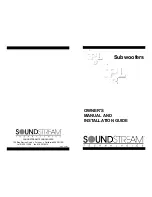
6
M ea sure m axim um po ssib le dim ensio ns
M ultiply wa ll thick nes s by 2
S ubtra ct this from e ach dim en sion to
a rrive at G ro ss In terna l Dim e nsion s
M u ltiply LxW xD to arrive at
G ross In tern al Volu m e
Ded uct Vf (volum e of the spe aker fram e )
from G ros s Inte rnal Volum e
B race s?
N o
Yes
C alcu late b race volum e and dedu ct
from G ross Internal Vo lum e
Ded uct Vf (volum e of the spe aker fram e )
from G ros s Inte rnal Volum e
You a re at N et Inte rnal Volum e
in cubic inch es (in )
3
To c onv ert to L ITERS :
Divide in
by 61 .03
To c onv ert to C UBIC FEET:
Divide in
by 17 28
3
3
ENCLOSURE VOLUME FLOWCHART
7
BUILDING THE ENCLOSURE
•
Determine the dimensions of your enclosure.
•
Be certain the box you have designed will fit into the location you have
chosen. Sometimes making a cardboard box with the same outside
dimensions is helpful.
•
Use 3/4 inch thick Medium Density Fiberboard (MDF) or High Density
Particleboard. It is preferable to cut the wood with a table saw to ensure
straight, even joints. If a table saw is not available, a circular saw is
acceptable.
•
Use a “T” square to verify precise right angle gluing.
•
Use a high quality wood glue and air nails or wood screws to assemble the
enclosure. Elmer’s
woodworker’s glue and Weldwood
work well. To
guarantee an airtight box, seal each inside joint with silicone sealant.
•
For Sealed Enclosures, stuff the chamber with 50-75% filling (approximately
1.5 pounds per cubic foot) of fiberglass insulation or Dacron
.
•
For Vented Enclosures, staple 1 inch thick fiberglass insulation or Dacron to
all walls of the enclosure except the baffle to which the woofer is mounted.
•
Use the supplied gasket to seal the woofer in the enclosure and eight(8)
wood screws or T-nuts and bolts. Progressively tighten each of the bolts or
screws to prevent warping the woofer frame.
•
Use slide-on connectors to attach speaker wires. Do not solder wires to the
SUGGESTED ENCLOSURES
The following designs include a variety of enclosure sizes and types.
Each design has two frequency response curves; one showing predicted
“In-Car” response, and the other showing “Half-Space Anechoic” (out-of-car)
frequency response. The performance difference between the two curves is a
result of the natural acoustics of an “average” automotive environment. This
“average” transfer function is only an approximation of what you may expect to
see in your car. Every car is different. Each curve was generated using 2.83
Volts across both voice coils in parallel and measured at 1 meter. Also, each
frequency response curve includes a 12 dB/octave low pass at 100 Hz for
sealed and vented enclosures and 200 Hz for bandpass enclosures. The
response curves can help you visualize relative performance differences
between designs. Read through the descriptions given for each enclosure and
select the one that suits your needs.
Remember: all suggested enclosure volumes are Net, and DO NOT include
woofer, port, and bracing displacement!
























